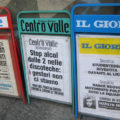Part 5, continued from part 4
After the disappointment of lunch, for dinner Enrico had armed himself with recommendations from our friends. We had a hard time finding the place – the street number he had was somehow wrong, and after we finally found it we had to kill an hour and a half because they would not actually open for dinner til 9 pm. We went to a nearby wine bar, where we tried three different Spanish wines (by the glass), all of them excellent.
Travel Tip: Ask the locals (anyone NOT connected with the hospitality industry) where to eat.
La Provenza, when we finally got to eat there, turned out to be worth all the trouble. The cuisine was somewhere between Provence and Catalunya, so we had more foie gras in our various starters – mine was a crisp flatbread with grilled vegetables and foie gras. My main course was duck breast with a sweet wine sauce and a fig-stuffed raviolo. I also had dessert, but don’t at present remember what it was, nor what Enrico and Ross ate. We each had a starter and a main course, and shared a bottle of wine, for a total price of 110 euros. I highly recommend La Provenza.
We tottered home to Sant Cugat after midnight, so Ross and I slept in the next morning while Enrico went off to the university. We had coffee and doughnuts (“doh-noots,” as the lady pronounced them) at a coffee shop near the train station, then ran into trouble trying to buy train tickets. For cash, the ticket machine would only take coins, of which I didn’t have any. It “couldn’t connect to network” for my US bank card, rejected my Italian bank card as “unauthorized for this transaction” (I’d seen that the day before at several attempts to withdraw cash at ATMs as well), and for my Visa cards wanted a PIN code which I don’t have. We had to ask for change at a nearby bar before we could finally get tickets and board a train.
Travel Tip: Carry coins to use in the ticket machines of the Barcelona train/metro system.




